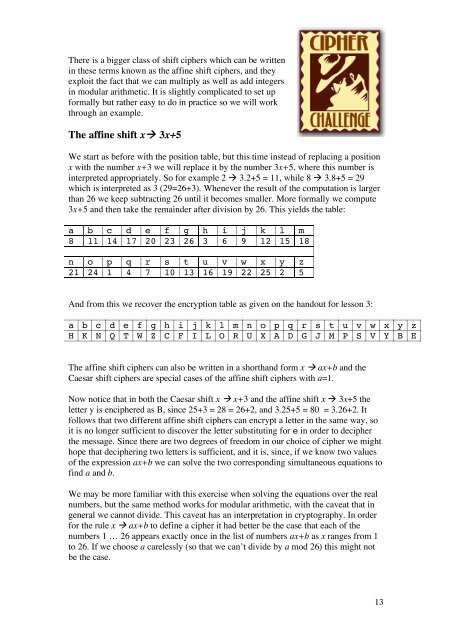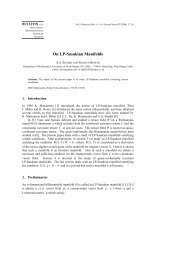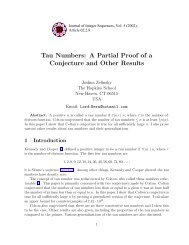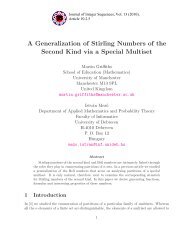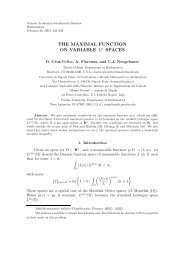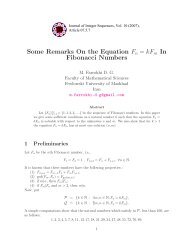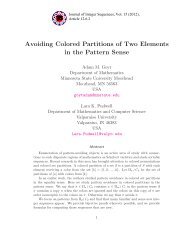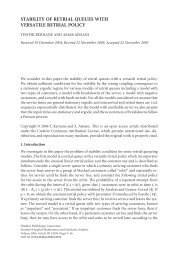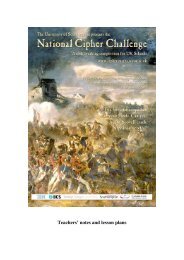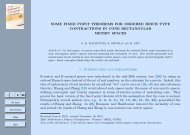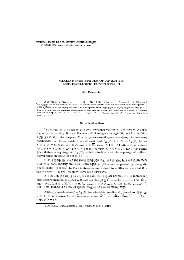Teachers - University of Southampton
Teachers - University of Southampton
Teachers - University of Southampton
Create successful ePaper yourself
Turn your PDF publications into a flip-book with our unique Google optimized e-Paper software.
There is a bigger class <strong>of</strong> shift ciphers which can be written<br />
in these terms known as the affine shift ciphers, and they<br />
exploit the fact that we can multiply as well as add integers<br />
in modular arithmetic. It is slightly complicated to set up<br />
formally but rather easy to do in practice so we will work<br />
through an example.<br />
The affine shift x! 3x+5<br />
We start as before with the position table, but this time instead <strong>of</strong> replacing a position<br />
x with the number x+3 we will replace it by the number 3x+5, where this number is<br />
interpreted appropriately. So for example 2 ! 3.2+5 = 11, while 8 ! 3.8+5 = 29<br />
which is interpreted as 3 (29=26+3). Whenever the result <strong>of</strong> the computation is larger<br />
than 26 we keep subtracting 26 until it becomes smaller. More formally we compute<br />
3x+5 and then take the remainder after division by 26. This yields the table:<br />
a b c d e f g h i j k l m<br />
8 11 14 17 20 23 26 3 6 9 12 15 18<br />
n o p q r s t u v w x y z<br />
21 24 1 4 7 10 13 16 19 22 25 2 5<br />
And from this we recover the encryption table as given on the handout for lesson 3:<br />
a b c d e f g h i j k l m n o p q r s t u v w x y z<br />
H K N Q T W Z C F I L O R U X A D G J M P S V Y B E<br />
The affine shift ciphers can also be written in a shorthand form x ! ax+b and the<br />
Caesar shift ciphers are special cases <strong>of</strong> the affine shift ciphers with a=1.<br />
Now notice that in both the Caesar shift x ! x+3 and the affine shift x ! 3x+5 the<br />
letter y is enciphered as B, since 25+3 = 28 = 26+2, and 3.25+5 = 80 = 3.26+2. It<br />
follows that two different affine shift ciphers can encrypt a letter in the same way, so<br />
it is no longer sufficient to discover the letter substituting for e in order to decipher<br />
the message. Since there are two degrees <strong>of</strong> freedom in our choice <strong>of</strong> cipher we might<br />
hope that deciphering two letters is sufficient, and it is, since, if we know two values<br />
<strong>of</strong> the expression ax+b we can solve the two corresponding simultaneous equations to<br />
find a and b.<br />
We may be more familiar with this exercise when solving the equations over the real<br />
numbers, but the same method works for modular arithmetic, with the caveat that in<br />
general we cannot divide. This caveat has an interpretation in cryptography. In order<br />
for the rule x ! ax+b to define a cipher it had better be the case that each <strong>of</strong> the<br />
numbers 1 … 26 appears exactly once in the list <strong>of</strong> numbers ax+b as x ranges from 1<br />
to 26. If we choose a carelessly (so that we can’t divide by a mod 26) this might not<br />
be the case.<br />
13


